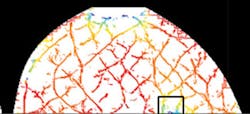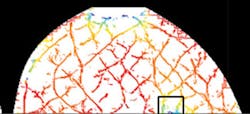OPTICAL MAMMOGRAPHY/NEAR-INFRARED MEASUREMENT: Technology advances breast cancer imaging
A portable scanner based on near-infrared (NIR) diffuse optical imaging offers a new way not only to detect breast cancer, but also to monitor treatment response. And it offers several advantages over traditional x-ray mammography: The non-ionizing technology eliminates radiation risk so multiple scans can be done in a short period of time. It also can produce functional real-time images of metabolic changes, such as levels of hemoglobin concentration and oxygenation. And, it's less invasive since it avoids greatly compressing the breast tissue.
The scanner proved effective in "proof of concept" tests; now the procedure is being studied in a five-year clinical trial funded by a $3.5 million grant from the National Institutes of Health. "The consensus is that x-ray mammography is very good at detecting lesions, but it's not as good at determining which suspicious lesions are really cancer," said Sergio Fantini, professor of biomedical engineering and leader of the research effort at Tufts University School of Engineering (Medford, MA).
Along similar lines, the National Institutes of Health's National Cancer Institute has awarded Vixar (Plymouth, MN) a Small Business Innovation Research (SBIR) Phase I contract to demonstrate the feasibility of a wavelength-tunable vertical-cavity surface-emitting laser (VCSEL) achieving a tuning range of 35 nm. Beckman Laser Institute at the University of California, Irvine is assisting the project, which will develop a swept near-infrared (NIR) light source for portable hyperspectral tomographic functional optical imaging of breast cancer. Phase II of the project will aim to optimize device performance, extend it to the full range of wavelength, and implement it in a handheld imager.

